: : Moving website : :
Yay!! Mr. T and Lol got the website working!! Will be moving hosts over the weekend. Massive move though. Will take time to move all the pictures over. Blogger doesn’t allow for file upload on websites outside their own. Cheh!
: : Moving website : :
Yay!! Mr. T and Lol got the website working!! Will be moving hosts over the weekend. Massive move though. Will take time to move all the pictures over. Blogger doesn’t allow for file upload on websites outside their own. Cheh!
: : Granny’s Cooking : :
Steamed fish!!! With strips of garlic, chillies and chop garlic. Pity that she didn’t put any salted vegetables inside. That would have been really nice.
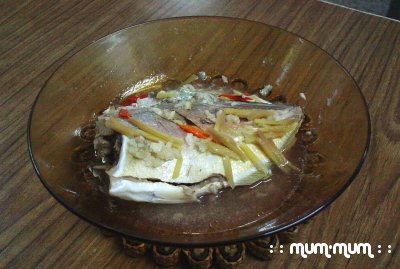
Picture was a bit messy ‘coz I came back late from work and Uncle Cyril wallop part of it already.
: : Chilli Peppers : :
Went back to Chilli Peppers for lunch again. The only different addition was the otak-otak patties. It’s actually grilled mashed fish wrapped out in leaves. However, we had the burger version minus the burgers. Tasted really good.
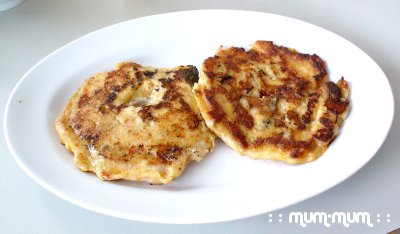
: : Snacks : :
Got disconnected while uploading this post. Urgh!
Anyway, Granny got some snacks over the weekend. Was munching on them while preparing this post.
Phong Pia
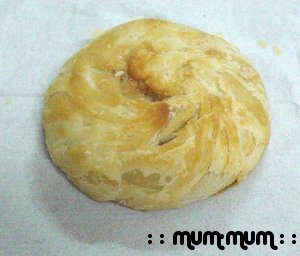
This is an excellent pastry. The filling is a sweet green-bean paste. Yep, the famous green beans that you-must-eat-else-you’ll-kill-by-midnight. This one was brilliant : paste was not too sweet and the pastry was not too salty. Note that the pastry crumbles easily so need to eat it with a plate.
Love Letters
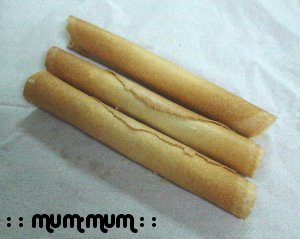
This version does not have any designs on them. Love letters is very sweet and crunchy. Found in abundance during festivals but you can still find it at the market or small grocery stalls. It is made by pouring some batter onto a pair of metal plates welded onto a pair of tongs. The metal plates are pressed tightly together and then heated over a small fire. Once the batter is cook, the round layer is quickly rolled up to the shape above.
: : Dinner at Auntie M’s : :
Had Sunday dinner with my auntie, cousin and his gf. The main course was done by my cuz but the appetizers and veggies were done by my Aunt.
Stuffed squid with mince chicken and carrots
Mixed veggies (sweet peas, baby corn, carrots)
Roast Chicken in Orange with Pork Stuffing
Stuffed potatoes?
Stuffed squid with mince chicken and carrots
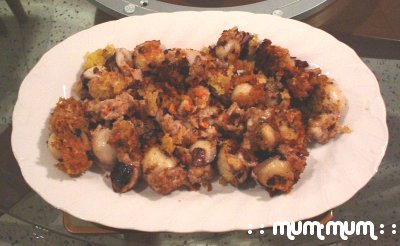
Smaller disaster because the bread crumbs wouldn’t stick to the squid. Think it’s because the skin of the baby squid was too smooth. Also, Auntie M suspected that she put too much stuffing in that they started coming out while she was frying them. It still tasted good and the slightly burnt parts just added to the flavour. You have to be there to understand what I meant by burnt.
Mixed veggies (sweet peas, baby corn, carrots)
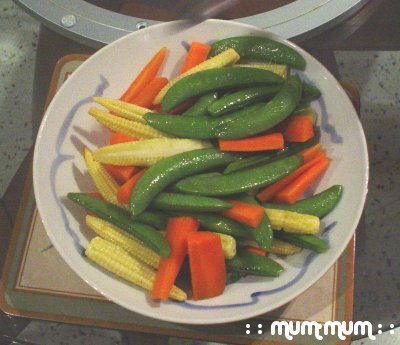
Yummy yum yum. I love sweet peas. They are so sweet and crunchy. However, to prepare it, you would need to remove the ends by a little bit and pull a little ‘string’ that comes off the skin. Also, the carrot was so sweet after cooking it that it was very yummy.
Roast Chicken in Orange with Pork Stuffing
No picture of the Roast Chicken. Yep, absent-minded Ms. Wena totally forgot another time. Couldn’t taste the orange, much to my cousin’s dismay. Suggested to him to use mandarin oranges rather than Sunkist. He put in the orange peel as well as the juice. 2 oranges, in fact. Think it’s something to do with Sunkist oranges that we get it. It’s always SO sour. However, the highlight was the stuffing. It tasted so delicious! He got it from Smart Supermarket, King’s Centre. Minced pork will not taste as nice. Probably because we didn’t know how to make it properly.
Stuffed Potatoes
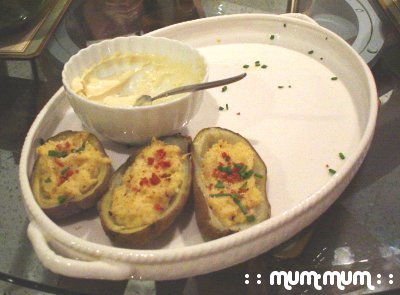
This was nice although I thought that the potatoes needed to be roasted until it was brown before serving. It was too pale. However, it still tasted good because of the bacon bits insides. The sauce was easy to do : a mix of salad cream and mayonaisse. Quick filling though so be forewarned.
It was a nice end an interesting weekend. Can’t wait for the time when Auntie M is cooking. She makes a mean tiramisu that is absolutely the best in Kuching. Sorry, by invitation only.
: : Chicken Curry : :
As promised, here is the recipe for Granny’s Curry Chicken. The number of ingredients here aren’t a lot because most of the spices have already been added into the curry paste.
1 small bowl of curry paste or 2 tablespoon of curry chicken powder
1/2 chicken, cut into smaller parts
A few strips of beancurd, broken into slightly smaller pieces
8 small purple shallots, sliced into half
2 tablespoon of cooking oil
Some water
A big wok with a lid to fit (approx. 20-30cm in diameter)
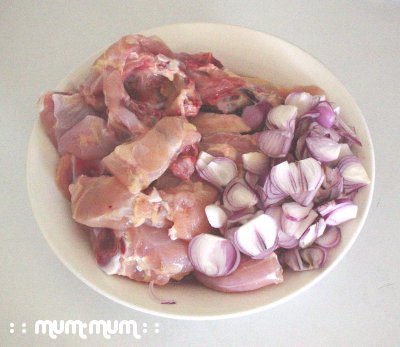
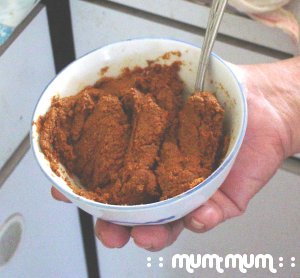
A note about the curry paste used here. The spices have already been added in, including the chilli powder. However, when using curry powder, you’ll need to use a lesser quantity in order to get the same taste.
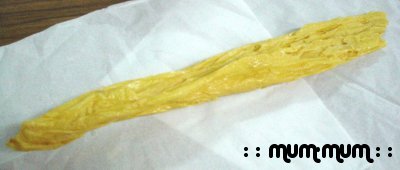
I luv beancurd! Yummy with curry! The picture shown is a full length one. For the curry, the beancurd is broken into strips of smaller lengths. Then, it’s later soak in water to rehydrate it so that it expands before being added into the curry.
Now onto the recipe!
Step 1
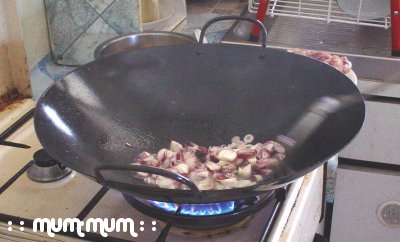
Heat up the oil on a slow fire until it is hot. To check, stick a dry spatula into the oil and press it against the wok. (Funny thing to note : over here, the spatula is called the frying stick!) If you start to see small bubbles come up, the oil is hot enough. Note that oil tends to spit if water is thrown into it. Slide the onions into the oil by pushing them from the side. Do not just drop them into the wok else the oil will start spitting. Fry the onions until they become soft and fragrant. Do not brown them.
Step 2
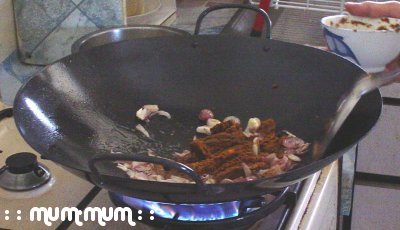
Fry the curry paste with the onions on a slow fire. Do not stop stirring. Add some water in if the paste is starting to dry up from the frying. No matter what happens, MUST NOT LET THE PASTE BURN!! Fry for a few minutes until there is a fragrant smell coming out. For first timers, be careful not to stand too close to the steam else your eyes will start to tear. I think it comes from the chilli inside the cooking.
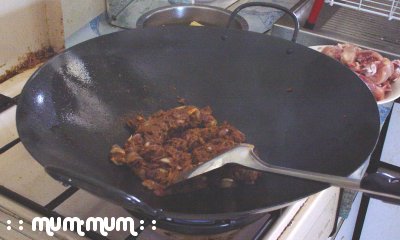
Step 3
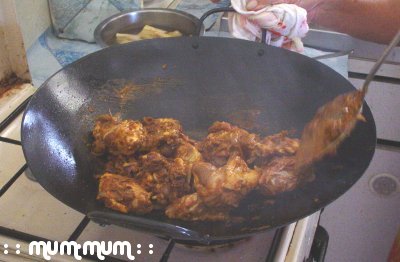
I hope that you still have a slow fire going. Big fire, smelly burnt smell. From the side of the wok, slowly slide the chicken in. The last thing you would want is a burnt mark on your skin, or worst, your face. (Incidently, if you do get burnt from hot cooking oil, the sap of a banana tree works wonders. Of course, you’ll end up a sticker but when one is in pain, one doesn’t care. Gotta look for a banana tree first!). Add some water if it gets too dry. Remember, the water is to prevent the chicken and curry paste from burning. Add in about 1 small bowl and stir the chicken until the outside is partially cook. Then, fill the wok with water : about half the wok should be filled with water. Turn up the file until the water starts to boil. Lower the fire and let the whole curry simmer. Cover the wok with a lid to cook the chicken faster. The lid creates a small pressure cooker so the chicken will be more tender.
Step 4
Once the chicken is cook, add in the hydrated beancurds. How to check if the chicken is cook? Try it lar! That’s the only way to tell. Simmer it until the beancurd is hot.
Sorry I didn’t add in a final picture of the finished dish. Completely forgot about it and when we had it for dinner again today, it looked to messy. Think there were some leftover so will take another pic tomorrow.
The orangey colour comes from a spice called tumeric. It doesn’t add much spicy-ness to the dish but rather the colour. Notice that there is no coconut milk added in? Great for people who are watching their diet. Granny wanted to lose weight so omitted the coconut milk in most of her curry cooking. Although, I do think that this version is a lot spice-er compared to the version with the coconut milk.
As for buying curry paste, it’s a 50-50 chance. Might get a good one, might not. Easiest way to find out is through word of mouth but do not be surprise if it doesn’t come out well. I guess it’s just plain luck. One thing good about curry paste is that it keeps in the freezer for ages.
So, that’s just about the 1st actual recipe for this blog. Granny says that she hopes everyone enjoys it. I know we do, every Sunday. It’s curry day every Sunday, 52 times a year.